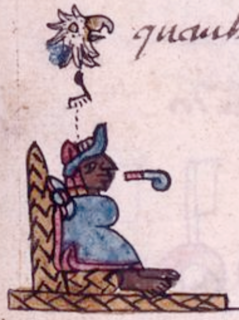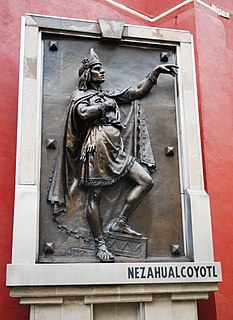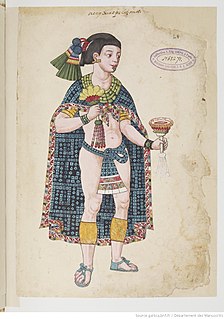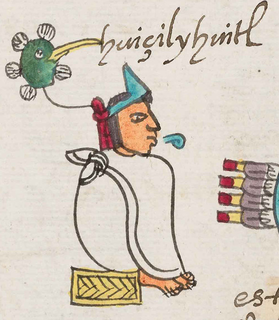Related Research Articles

Axayacatl was the sixth tlatoani of the altepetl of Tenochtitlan and Emperor of the Aztec Triple Alliance.

Cuauhtémoc, also known as Cuauhtemotzín, Guatimozín, or Guatémoc, was the Aztec ruler (tlatoani) of Tenochtitlan from 1520 to 1521, making him the last Aztec Emperor. The name Cuauhtemōc means "one who has descended like an eagle", and is commonly rendered in English as "Descending Eagle", as in the moment when an eagle folds its wings and plummets down to strike its prey. This is a name that implies aggressiveness and determination.

In Aztec mythology, Huitzilopochtli is the deity of war, sun, human sacrifice, and the patron of the city of Tenochtitlan. He was also the tribal god of the Mexicas, also known as the Aztecs, of Tenochtitlan. Many in the pantheon of deities of the Aztecs were inclined to have a fondness for a particular aspect of warfare. However, Huitzilopochtli was known as the primary god of war in ancient Mexico. Since he was the patron god of the Mexica, he was credited with both the victories and defeats that the Mexica people had on the battlefield. The people had to make sacrifices to him to protect the Aztec from infinite night. He wielded Xiuhcoatl, the fire serpent, as a weapon, thus also associating Huitzilopochtli with fire.

Nezahualcoyotl was a scholar, philosopher (tlamatini), warrior, architect, poet and ruler (tlatoani) of the city-state of Texcoco in pre-Columbian era Mexico. Unlike other high-profile Mexican figures from the century preceding Spanish conquest of the Aztec Empire, Nezahualcoyotl was not fully Mexica; his father's people were the Acolhua, another Nahuan people settled in the eastern part of the Valley of Mexico, on the coast of Lake Texcoco. His mother, however, was the sister of Chimalpopoca, the Mexica king of Tenochtitlan.

Nezahualpilli was king (tlatoani) of the Mesoamerican city-state of Texcoco, elected by the city's nobility after the death of his father, Nezahualcoyotl, in 1472. Nezahuapilli's mother was Azcalxochitzin, who married Nezahualcoyotl after the death of her first husband, King Cuahcuauhtzin of Tepechpan.

Miguel León-Portilla was a Mexican anthropologist and historian, specializing in Aztec culture and literature of the pre-Columbian and colonial eras. Many of his works were translated to English and he was a well-recognized scholar internationally. In 2013, the Library of Congress of the United States bestowed on him the Living Legend Award.

HuitzilihuitlNahuatl pronunciation: [wit͡siˈliwit͡ɬ](listen) or Huitzilihuitzin was the second Tlatoani or king of Tenochtitlan. According to the Codex Chimalpahin, he reigned from 1390 to 1415, according to the Codex Aubin, he reigned from 1396 to 1417 and according to the Codex Chimalpopoca, he reigned from 1403 to 1417.

The Fall of Tenochtitlan, the capital of the Aztec Empire, was a decisive event in the Spanish conquest of the empire. It occurred in 1521 following extensive manipulation of local factions and exploitation of pre-existing political divisions by Spanish conquistador Hernán Cortés. He was aided by indigenous allies, and his interpreter and companion La Malinche.
The Anales de Tlatelolco is a codex manuscript written in Nahuatl, using Latin characters, by anonymous Aztec authors. The text has no pictorial content. Although there is an assertion that the text was a copy of one written in 1528 in Tlatelolco, only seven years after the fall of the Aztec Empire, James Lockhart argues that there is no evidence for this early date of composition, based on internal evidence of the text. However, he supports the contention that this is an authentic conquest account, arguing that it was composed about 20 years after the conquest in the 1540s, and contemporaneous with the Cuernavaca censuses. Unlike the Florentine Codex and its account of the conquest of Mexico, the Annals of Tlatelolco remained in indigenous hands, providing authentic insight into the thoughts and outlook of the newly conquered Nahuas.

The Aztecs were a Pre-Columbian Mesoamerican people of central Mexico in the 14th, 15th, and 16th centuries. They called themselves Mēxihcah.
Xayacamach of Tizatlan was an Aztec poet from the Pre-Columbian state of Tlaxcallan, born between 1450 and 1455.

Xicotencatl I or Xicotencatl the Elder was a long-lived tlatoani (king) of Tizatlan, a Nahua altepetl within the pre-Columbian confederacy of Tlaxcala, in what is now Mexico.

The Broken Spears: The Aztec Account of the Conquest of Mexico is a book by Mexican historian Miguel León-Portilla, translating selections of Nahuatl-language accounts of the Spanish conquest of the Aztec Empire. It was first published in Spanish in 1959, and in English in 1962. The most recent English edition was published in 2007 (ISBN 978-0807055007).

The Mexica, or Mexicas, were a Nahuatl-speaking indigenous people of the Valley of Mexico who were the rulers of the Aztec Empire. The Mexica established Mexico Tenochtitlan, a settlement on an island in Lake Texcoco, in 1325. A dissident group in Mexico-Tenochtitlan separated and founded the settlement of Mexico-Tlatelolco with its own dynastic lineage. In 1521, they were conquered by an alliance of Spanish conquistadors and indigenous people including the Tlaxcaltecs led by Fernando (Hernán) Cortés.
The Cantares Mexicanos is the name given to a manuscript collection of Nahuatl songs or poems recorded in the 16th century. The 91 songs of the Cantares form the largest Nahuatl song collection, containing over half of all known traditional Nahuatl songs. It is currently located in the National Library of Mexico in Mexico City. A description is found in the census of prose manuscripts in the native tradition in the Handbook of Middle American Indians.

Tlatelolco was a pre-Columbian altepetl, or city-state, in the Valley of Mexico. Its inhabitants, known as the Tlatelolca, were part of the Mexica, a Nahuatl-speaking people who arrived in what is now central Mexico in the 13th century. The Mexica settled on an island in Lake Texcoco and founded the altepetl of Mexico-Tenochtitlan on the southern portion of the island. In 1337, a group of dissident Mexica broke away from the Tenochca leadership in Tenochtitlan and founded Mexico-Tlatelolco on the northern portion of the island. Tenochtitlan was closely tied with its sister city, which was largely dependent on the market of Tlatelolco, the most important site of commerce in the area.
Tetlepanquetzal was the fourth Tepanec tlatoani (ruler) of Tlacopan, and reigned after 1503 as a tributary of the Mexican emperor Moctezuma II, whom he assisted in the first defence of Mexico. Afterward he was one of the principal auxiliaries of Cuauhtémoc. When the city was finally taken, 13 August, 1521, he was made prisoner and tortured, together with Cuauhtémoc, by the Spaniards to coerce them into revealing the hiding place of the imperial treasure.
Tochihuitzin, son of Itzcoatl, was ruler of Teotlatzinco. Tochihuitzin and his brothers helped save Nezahualcoyotl from being captured by the Azcapotzalca that Nezahualcoyotl found refuge with the Mexica. According to Cronica Mexicayotl, Tochihuitzin married Achihuapoltzin, daughter of Tlacaelel. After the battle against the city of Azcapotzalco, Tochihuitzin became ruler of Teotlatzinco.
Macuilxochitzin, also referred to in some texts as Macuilxochitl, was a poet (cuicanitl) during the peak years of the Aztec civilization. She was the daughter of Tlacaélael, a counselor to the Aztec kings and the niece of the Tlatoani warrior Axayacatl. She lived through the height of the Aztec civilization's expansion. Her life and works are an example of gender parallelism in pre-Hispanic Mexico, where women were given the same opportunities enjoyed by men.
References
- ↑ "tlacatecatl". Gran Diccionario Náhuatl (in Spanish). Retrieved June 11, 2019.
- ↑ Miguel Leon-Portilla (1978). Trece Poetas del Mundo Azteca[Thirteen Poets of the Aztec World] (in Spanish) (2nd, 1972 ed.). Mexico City: Universidad Nacinal Autonoma de Mexico. pp. 171–179.
- Leon-Portilla, Miguel (2000). Fifteen Poets of the Aztec World. Oklahoma: University of Oklahoma Press.